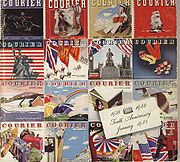
Courier (Quarterly)
Encyclopedia

World War II
World War II, or the Second World War , was a global conflict lasting from 1939 to 1945, involving most of the world's nations—including all of the great powers—eventually forming two opposing military alliances: the Allies and the Axis...
, in spite of the paper restrictions imposed. Each issue included approximately 180 pages, 7½ inches wide by 7 inches deep: at the time, Britain's daily newspapers were rationed to only four pages.
There were usually four issues a year (although there were some issues that were missed). The price was three shillings, A Penguin pocket book
Penguin Books
Penguin Books is a publisher founded in 1935 by Sir Allen Lane and V.K. Krishna Menon. Penguin revolutionised publishing in the 1930s through its high quality, inexpensive paperbacks, sold through Woolworths and other high street stores for sixpence. Penguin's success demonstrated that large...
only cost six pence in 1940 (one sixth of the price). The sub-title was "Picturing Today". Each copy had a large number of Satire articles, one or more shaggy dog story was always included. In addition there was a section of art photographs, including chaste "nude studies" of women, countryside and seascape photographs. Some issues had coloured fold=outs and others had humour inserts printed on standard paper .
The contents were grouped into the following sections:
- Satire - which included cartoons and a short topical article, as well as a "Shaggy Dog" story.
- Transatlantic - Articles about New York and other US news items.
- Life in Pictures - Photos and other illustrations.
- Day and Age - General, Technical and Historic articles.
- Departments - including; The Mode, The Stage, The Screen, and The Page.
- Fiction - Short stories, including a handful by the better-known British authors of the day, including A A Milne, SakiSakiHector Hugh Munro , better known by the pen name Saki, and also frequently as H. H. Munro, was a British writer whose witty, mischievous and sometimes macabre stories satirised Edwardian society and culture. He is considered a master of the short story and often compared to O. Henry and Dorothy...
, John GalsworthyJohn GalsworthyJohn Galsworthy OM was an English novelist and playwright. Notable works include The Forsyte Saga and its sequels, A Modern Comedy and End of the Chapter...
, and Robert Standish.
The production of the Courier was extended after 1951 as a monthly publication, with a different format and fewer pages.
During the fifties, the Courier changed to a 100-plus page magazine. It incorporated the material from the discontinued publication called TO-DAY. This format had the following major sections (*) and their sub-sections (**):
- This Day and Age
- Out of the Letter Box
- Editorial
- (This sub-section was used for articles and other material from outside sources. **The Month
- The Grand National
- Life In Pictures
- This section always carried pictures of both rural and urban areas throughout Great Britain.
- The other material varied according to the season and availability.
- The Backward Glance
- A combination of original and reprint material stressing the achievements of the English peoples. There was not much printed from any of the other members of the Comonwealth; but, you would occasionally see material from, or about, India and Canada.
- Satire
- Fiction
- Departments
- Cuisine
- The Garden,
- The Mode, (Continental Fashion)
- The Motor,
- The Stage'
- The Screen,
- The Record,
- The Page, (Various articles that did not fit into the usual material of this magazine).
- Bridge, (The Card Game)
- Chess
- Headliners
This heading covered the global news and Britain's Political Scene.
It is believed to have been discontinued in the 1960s.
A sister magazine was published monthly by Norman Kark called Bandwagon. It was a smaller format than the Courier, but printed on the same high quality art paper. It started just after the end of the Second World War and stopped publishing in the early 1950s. The contents was on all aspects of entertainment, with sections on art, fashion, music (both classic and popular), the stage, the cinema and biographic sketches.

